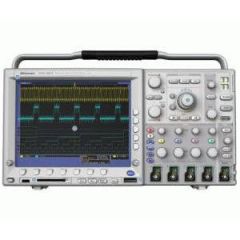
MSO4034 Tektronix Mixed Signal Oscilloscope
350 MHz Channels: 4 Analog + 16 Digital Sample Rate: 2.5 GS/s Record Length: 10 MPts 50,000 wfm/s
REQUEST A QUOTE
MSO4034 Tektronix Mixed Signal Oscilloscope
Detail
350 MHz
Channels: 4 Analog + 16 Digital
Sample Rate: 2.5 GS/s
Record Length: 10 MPts
50,000 wfm/s Maximum Waveform Capture Rate
Suite of Advanced Triggers
Wave Inspector® Controls Provide Unprecedented Efficiency in Waveform Analysis
10.4 in. (264 mm) XGA Color Display
USB and CompactFlash on Front Panel for Quick and Easy Storage
USB Plug-and-Play PC Connectivity
Small Footprint and Lightweight
TekVPI® Probe Interface Supports Active, Differential, and Current Probes for Automatic Scaling and Units
Mixed Signal Design and Analysis
Multichannel Setup and Hold Triggering
MagniVu™ 60.6 ps Technology Provides Finer Timing Resolution
Parallel Bus Trigger and Analysis
Per-channel Threshold Settings
Next-generation Digital Waveform Display
Applications
Embedded Design and Debug
Mixed Signal Design and Debug
Investigation of Transient Phenomena
Power Measurements
Video Design and Debug
Automotive Electronics Design and Debug
The MSO4034 provides all the features and benefits of the DPO4034, but adds 16 integrated digital channels, enabling you to visualize and correlate analog and digital signals on a single instrument. This integration extends triggering functionality across all 20 channels providing pattern and state triggering ideal for debugging mixed analog and digital designs.
Provided applications include NI LabVIEW SignalExpress™ Tektronix Edition LE, OpenChoice® Desktop and Microsoft Excel and Word toolbars enabling fast and easy direct communication with your Windows PC. USB and CompactFlash ports on the front panel enable simple transfer of screenshots, instrument settings, and waveform data in the palm of your hand.
When it comes to mixed signal design and debug, you want your instrument to be intuitive so you can start solving problems quickly. The MSO4000 Series drives like an oscilloscope, the tool you already know how to use. You do not have to relearn how to use the instrument every time you turn it on.
The first digital oscilloscopes could capture and store only 500 points, which made it very difficult to acquire all relevant information around the event being investigated. Over the years, oscilloscope manufacturers have provided longer and longer record lengths to meet market demands for long capture windows with high resolution, to the point that most mid-range oscilloscopes either come standard with, or can be optionally upgraded to, multi-megapoint record lengths. These megapoint record lengths often represent thousands of screens worth of signal activity. While standard record lengths have increased greatly over the years and can now satisfy the vast majority of applications in the marketplace, tools for effectively and efficiently viewing, navigating, and analyzing long record length acquisitions have been sorely neglected until now.
The MSO/DPO4000 Series redefines expectations for working with long record lengths with the following innovative Wave Inspector controls:
The Power to Solve Problems Quickly
The MSO/DPO4000 Series offers a variety of analytical solutions including cursors, 29 automatic measurements, statistics, and waveform math. Despite a tiny footprint (only 5.4 in. deep) and lightweight (11 lb.), the MSO/DPO4000 Series offers exceptional performance, a large 10.4 in. XGA display and knob-per-channel vertical controls.
The TekVPI™ probe interface sets the standard for ease of use in probing. TekVPI probes feature status indicators and controls, as well as a probe menu button right on the comp box itself. This button brings up a probe menu on the oscilloscope display with all relevant settings and controls for the probe. The TekVPI interface utilizes a new probe power management architecture enabling direct attachment of current probes without requiring a separate, bulky power supply. Finally, TekVPI probes can be controlled remotely using USB, GPIB, or Ethernet, enabling more versatile solutions in ATE environments.
Microprocessors, FPGAs, Analog-to-Digital Converters (ADCs), and Digital-to-Analog Converters (DACs) are all examples of ICs that present unique measurement challenges in today’s embedded designs. The MSO4000 Series Mixed-Signal Oscilloscopes offer the addition of 16 digital channels. These channels are tightly integrated into the oscilloscope’s user interface, simplifying operation and making it possible to solve mixed signal issues more easily.
The MSO4000 Series has multiple transition detection hardware. When the system detects multiple transitions, the user will see a white edge on the display. White edges indicate that more information is available by zooming in or acquiring at faster sampling rates. In most cases zooming in will reveal the pulse that was not viewable with the previous settings. If the white edge is still present after zooming in as far as possible, this indicates that increasing the sample rate on the next acquisition will reveal higher frequency information than the previous settings could acquire.
Channel setup on an MSO can often be time consuming as compared to the traditional oscilloscope. This process often includes probing the device-under-test, labeling the channels and positioning the channels on screen. The MSO4000 Series simplifies this process by allowing the user to group digital waveforms and enter waveform labels using a USB keyboard.
By simply placing digital waveforms next to each other, they form a group. Once a group is formed, you can position all the channels contained in that group together. This greatly reduces the normal setup time associated with positioning channels individually.
Additional Application Support
Standard features such as IRE and mV graticules, holdoff by fields, video polarity, and an Autoset smart enough to detect video signals, make the MSO/DPO4000 Series the easiest to use oscilloscope on the market for video applications. And with up to 1 GHz bandwidth and four analog inputs the MSO/DPO4000 Series provides ample performance for analog and digital video use.
Finally, the MSO/DPO4000 Series video functionality is further extended with the optional DPO4VID video application module. DPO4VID provides the industry’s most complete suite of HDTV and custom (nonstandard) video triggers.
Option
| Option |
Description |
| DPO4AUTOMAX |
FlexRay, CAN, and LIN serial triggering and analysis module for the DPO4000/MSO4000 Series |
| DPO4EMBD |
Embedded Serial Triggering and Analysis Module for the DPO4000/MSO4000 Series |
Download
Video

